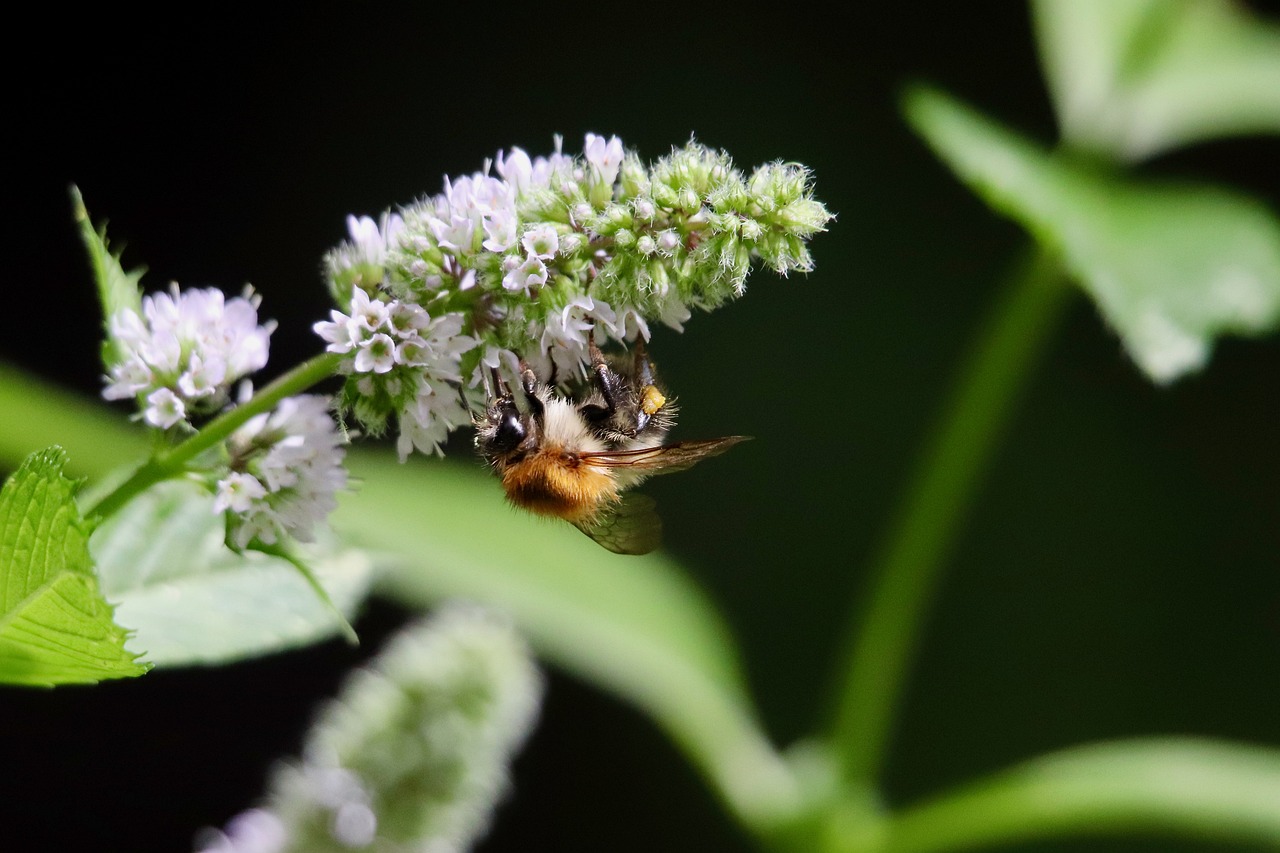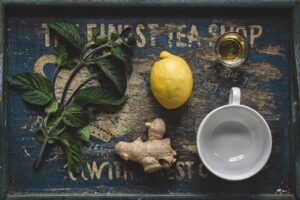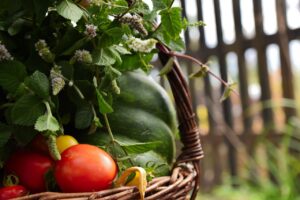Mint
Overview
Mint, with its distinct fresh and spicy aroma, is an easy-to-identify hardy perennial loved for both culinary and medicinal purposes. With its opposite leaves and characteristic square stems, this member of the Lamiaceae family can be a refreshing addition to gardens and kitchens alike.

Characteristics
Known for its aromatic leaves, square stems, and versatile culinary and medicinal applications.
Region
Mint is commonly grown in temperate regions worldwide.
Natural Habitat
Typically found in moist, temperate environments along stream banks and in fields.
Cultivation
Prefers full sun to partial shade, consistent moisture, and well-drained, fertile soil enriched with organic matter.
Uses and Benefits
Mint bursts with flavor and it’s an unbeatable addition to a variety of dishes and drinks. Described as a flavor enhancer, the herb puts a delectable spin on everything from lamb to mojitos, and its refreshing edge can lift a simple glass of iced tea to new heights5. Beyond the kitchen, mint earns its stripes in the health department. It’s frequently consumed to soothe uneasy stomachs and support digestion, capitalizing on its natural therapeutic properties5.
Peppermint tea isn’t just a bedtime treat; it’s a well-regarded herbal remedy. But mint’s magic doesn’t end with taste and health. If you’re dealing with uninvited critters, mint leaves—either fresh or dried—might just be the eco-friendly deterrent you need, showing mice and rats the door4. Be cautious though, as these leaves aren’t pet-friendly and can harm your furry friends4.
Mint’s versatility and benefits are as abundant as its leaves in summer. Here are some of the top uses and benefits of this refreshing herb:
- Enhances flavors in a wide range of recipes, from savory dishes to refreshing beverages
- Soothes digestive issues and supports healthy digestion
- Serves as a natural pest deterrent, helping keep mice and rats at bay
- Provides a refreshing and therapeutic herbal tea remedy
Whether used in your favorite recipe or as a natural remedy, mint is a versatile and beneficial addition to any home garden or wildcrafting endeavor. Embrace the power of this humble herb and discover the many ways it can enhance your life.

Cultivation Tips
For those keen to grow their own mint, here are some helpful tips to keep your plants flourishing. Ensure your mint gets plenty of sunlight; these plants love a bright, sunny spot. However, they can tolerate partial shade, which can help prevent them from drying out too quickly.
Keep the soil consistently moist but not waterlogged. Mint plants are thirsty but don’t like soggy feet! It’s crucial to have well-draining soil to avoid root rot—a condition that can be detrimental to your plant. Add organic matter like compost to enrich the soil and encourage robust growth3.
Mint can take the cold, but it thrives when it’s warm, so monitor the seasonal temperatures for optimal growth rates2. Lastly, consider planting your mint in pots or containers to contain its vigorous spreading. This way, you get to enjoy the mint without it taking over your garden5.
Here are some additional tips for a bountiful mint harvest:
- Fertilize regularly: Feed your mint plants with a balanced, water-soluble fertilizer every few weeks to promote healthy growth and lush foliage.
- Pinch back stems: Encourage bushier growth by pinching back the stems. This also helps to prevent the plant from becoming leggy and promotes fuller, more compact growth.
- Harvest frequently: Regular harvesting encourages your mint to produce more leaves. Snip off the top leaves as needed, ensuring that you leave enough foliage for the plant to continue growing.
- Divide and replant: Mint can become overcrowded over time. Divide your plants every couple of years and replant them to maintain their vigor and prevent overcrowding.
With these cultivation tips, your Mentha plants should be a fragrant and delightful addition to your garden. Enjoy the fresh, invigorating aroma and versatile flavors that homegrown mint has to offer!
Seasonal Considerations
For those keen to grow their own mint, here are some helpful tips to keep your plants flourishing. Ensure your mint gets plenty of sunlight; these plants love a bright, sunny spot. However, they can tolerate partial shade, which can help prevent them from drying out too quickly.
Keep the soil consistently moist but not waterlogged. Mint plants are thirsty but don’t like soggy feet! It’s crucial to have well-draining soil to avoid root rot—a condition that can be detrimental to your plant. Add organic matter like compost to enrich the soil and encourage robust growth3.
Mint can take the cold, but it thrives when it’s warm, so monitor the seasonal temperatures for optimal growth rates2. In regions with cold winters, mint will die back and go dormant, resprouting from the roots in spring. Protect your mint plants during harsh winters by applying a layer of mulch around the base of the plant to insulate the roots.
Summer is peak growing season for mint. Ensure the plants receive adequate water during hot, dry spells to prevent wilting and maintain healthy growth. Regularly pinch back the tips of the stems to encourage bushier growth and prevent flowering, which can cause the leaves to become less flavorful.
Lastly, consider planting your mint in pots or containers to contain its vigorous spreading. This way, you get to enjoy the mint without it taking over your garden5. With these cultivation tips, your mint should be a fragrant and delightful addition to your plant collection.

Issues and Troubleshooting
While mint is a resilient herb that usually thrives with minimal fuss, it’s not without its share of possible hiccups. Two common issues to watch out for are:
- Mint rust: A fungus that causes small, bright orange spots to form on the leaves.
- Verticillium wilt: Marked by drooping and discolored leaves.
Both conditions are a sign to keep a close eye on watering practices and ensure good air circulation around your plants. Overcrowding can lead to poor air flow and damp conditions, which can provoke problems such as powdery mildew. To combat this, thin out your plants regularly.
If you notice your mint looking a bit lackluster, it may be hungering for nutrients. A balanced, slow-release fertilizer can pep it up. Don’t ignore little visitors either; aphids and spider mites find mint quite tempting. If you see them making a snack of your mint, a gentle spray of soapy water can help send them packing.
Remember that while mint is robust, it can sometimes escape its bounds and become invasive. Keep it contained with barriers or grow it in pots to maintain good plant manners in your garden space1 4.
History and Folklore
Mint, with its refreshingly cool aroma, has been entwined with human history and folklore for centuries. The ancient Greeks valued mint for its invigorating properties, using it to clean their banqueting tables and rubbing it on their arms to energize themselves.
In the realm of mythology, the story of Minthe, a nymph who was transformed into the mint plant, is a testament to the herb’s revered vitality and vigor. This tale has been passed down through generations, solidifying mint’s place in both history and legend.
As the Roman Empire expanded, they brought mint to Britain, appreciating its fragrant bouquet. Throughout the Middle Ages, mint remained a popular ingredient in potpourri, adding its fresh scent to the mix of dried flowers and spices.
Mint’s significance extends beyond its aromatic qualities, as it has long been a symbol of hospitality in various cultures. In ancient Greece, hosts would strew mint on the floor to welcome their guests, a tradition that showcased their warmth and generosity. This custom has endured in parts of the Middle East, where mint is still offered as a sign of friendship and hospitality.
From its use in ancient rituals to its role in mythology and its enduring symbolism, mint has left an indelible mark on human history and folklore. Its refreshing aroma and invigorating properties have made it a beloved herb for centuries, weaving a rich tapestry of cultural significance that continues to captivate us to this day.
References
1. How to Grow and Care for Mint – The Spruce, https://www.thespruce.com/growing-mint-1402628
2. Mint Growing Conditions: Soil, Sunlight, Spacing, and More, https://gardeningbreak.com/best-growing-conditions-for-mint-easy-overview/
3. How to Grow Mint Plants (with Tips for Starting Cuttings), https://commonsensehome.com/how-to-grow-mint-plants/
4. Mint – All you Need to Know – Gardenia, https://www.gardenia.net/guide/learn-how-to-grow-and-care-mint
5. Mint: Planting, Growing, and Harvesting Mint Plants | The Old Farmer’s …, https://www.almanac.com/plant/mint
Image Credit: Nennieinszweidrei
Image Credit: Leon_Ting
Image Credit: 753tomas753
Nicolas Duval
Nicolas is a passionate advocate for nature and the art of wildcrafting. His dedication shines through in Wildcraftia, a website he meticulously crafted to serve as a haven for nature enthusiasts worldwide. Driven by a deep appreciation for nature’s connection to humanity, Nicolas embarked on his journey in 2011 with SmokableHerbs, a platform showcasing his love for nature’s bounty. Building upon this foundation, he established Smokably, a thriving online store offering premium herbs and blends to a global audience.
